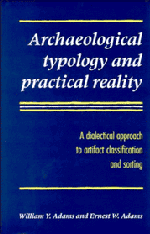 Archaeological Typology and Practical Reality
Archaeological Typology and Practical Reality Book contents
- Frontmatter
- Contents
- List of figures
- List of tables
- The archaeologist's preface
- The philosopher's preface
- PART I Introductory
- PART II The nature of types and typologies
- PART III Typology in action: the Medieval Nubian Pottery Typology
- 9 Origin and development of the Nubian Typology
- 10 Basic features of the Nubian Typology
- 11 The uses of the Nubian Typology
- 12 Philosophical implications
- PART IV Pragmatics of archaeological typology
- PART V Classification, explanation, and theory
- Appendices
- References
- Index
9 - Origin and development of the Nubian Typology
Published online by Cambridge University Press: 23 November 2009
- Frontmatter
- Contents
- List of figures
- List of tables
- The archaeologist's preface
- The philosopher's preface
- PART I Introductory
- PART II The nature of types and typologies
- PART III Typology in action: the Medieval Nubian Pottery Typology
- 9 Origin and development of the Nubian Typology
- 10 Basic features of the Nubian Typology
- 11 The uses of the Nubian Typology
- 12 Philosophical implications
- PART IV Pragmatics of archaeological typology
- PART V Classification, explanation, and theory
- Appendices
- References
- Index
Summary
The authors of this book are familiar, in theory or in practice, with quite a number of typologies, and so presumably are most readers. Since we hope to reach a wide and varied audience, however, we cannot be sure that all or even most of our readers will be familiar with the same examples of the genre. Rather than illustrate our points with examples from a number of different typologies, we have chosen to describe in detail one particular typology, which will provide many of the illustrative examples we will discuss in subsequent chapters. The typology chosen is WYA's Classification of Medieval Nubian Pottery Wares (WYA 1986a), hereinafter called the Nubian Pottery Typology.
This seemingly egocentric procedure can be defended on several grounds. The typology is a fairly complex one, with enough internal variability to illustrate most of the points we want to make. It was developed for a specific purpose, and its utility in serving that purpose can be not only described but measured. Most importantly of all, one author (WYA) is familiar in detail not only with the typology but with its family history and secrets. This makes it possible to consider how the scheme first arose, and the hits and misses of its development – a privilege we are not often given in discussions of typologies (cf. Dunnell 1971b: 139; Gardin 1980: 81).
- Type
- Chapter
- Information
- Archaeological Typology and Practical RealityA Dialectical Approach to Artifact Classification and Sorting, pp. 99 - 109Publisher: Cambridge University PressPrint publication year: 1991


